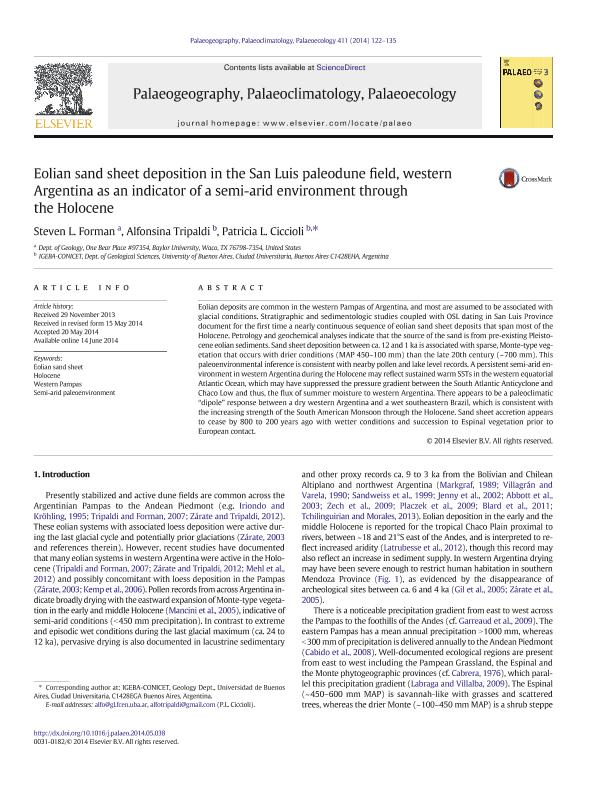Mostrar el registro sencillo del ítem
dc.contributor.author
Forman, Steven L.
dc.contributor.author
Tripaldi, Alfonsina

dc.contributor.author
Ciccioli, Patricia Lucia

dc.date.available
2018-01-15T20:58:48Z
dc.date.issued
2014-06
dc.identifier.citation
Tripaldi, Alfonsina; Forman, Steven L.; Ciccioli, Patricia Lucia; Eolian sand sheet deposition in the San Luis paleodune field, western Argentina as an indicator of a semi-arid environment through the Holocene; Elsevier Science; Palaeogeography, Palaeoclimatology, Palaeoecology; 411; 6-2014; 122-135
dc.identifier.issn
0031-0182
dc.identifier.uri
http://hdl.handle.net/11336/33359
dc.description.abstract
Eolian deposits are common in the western Pampas of Argentina, and most are assumed to be associated with glacial conditions. Stratigraphic and sedimentologic studies coupled with OSL dating in San Luis Province document for the first time a nearly continuous sequence of eolian sand sheet deposits that span most of the Holocene. Petrology and geochemical analyses indicate that the source of the sand is from pre-existing Pleistocene eolian sediments. Sand sheet deposition between ca. 12 and 1 ka is associated with sparse, Monte-type vegetation that occurs with drier conditions (MAP 450–100 mm) than the late 20th century (~ 700 mm). This paleoenvironmental inference is consistent with nearby pollen and lake level records. A persistent semi-arid environment in western Argentina during the Holocene may reflect sustained warm SSTs in the western equatorial Atlantic Ocean, which may have suppressed the pressure gradient between the South Atlantic Anticyclone and Chaco Low and thus, the flux of summer moisture to western Argentina. There appears to be a paleoclimatic “dipole” response between a dry western Argentina and a wet southeastern Brazil, which is consistent with the increasing strength of the South American Monsoon through the Holocene. Sand sheet accretion appears to cease by 800 to 200 years ago with wetter conditions and succession to Espinal vegetation prior to European contact.
dc.format
application/pdf
dc.language.iso
eng
dc.publisher
Elsevier Science

dc.rights
info:eu-repo/semantics/openAccess
dc.rights.uri
https://creativecommons.org/licenses/by-nc-nd/2.5/ar/
dc.subject
Eolian Sand Sheet
dc.subject
Holocene
dc.subject
Western Pampas
dc.subject
Semi-Arid Paleoenvironment
dc.subject.classification
Meteorología y Ciencias Atmosféricas

dc.subject.classification
Ciencias de la Tierra y relacionadas con el Medio Ambiente

dc.subject.classification
CIENCIAS NATURALES Y EXACTAS

dc.title
Eolian sand sheet deposition in the San Luis paleodune field, western Argentina as an indicator of a semi-arid environment through the Holocene
dc.type
info:eu-repo/semantics/article
dc.type
info:ar-repo/semantics/artículo
dc.type
info:eu-repo/semantics/publishedVersion
dc.date.updated
2018-01-12T19:49:05Z
dc.journal.volume
411
dc.journal.pagination
122-135
dc.journal.pais
Países Bajos

dc.journal.ciudad
Amsterdam
dc.description.fil
Fil: Forman, Steven L.. Baylor University; Estados Unidos
dc.description.fil
Fil: Tripaldi, Alfonsina. Consejo Nacional de Investigaciones Científicas y Técnicas. Oficina de Coordinación Administrativa Ciudad Universitaria. Instituto de Geociencias Basicas, Aplicadas y Ambientales de Buenos Aires. Universidad de Buenos Aires. Facultad de Ciencias Exactas y Naturales. Instituto de Geociencias Basicas, Aplicadas y Ambientales de Buenos Aires; Argentina
dc.description.fil
Fil: Ciccioli, Patricia Lucia. Consejo Nacional de Investigaciones Científicas y Técnicas. Oficina de Coordinación Administrativa Ciudad Universitaria. Instituto de Geociencias Basicas, Aplicadas y Ambientales de Buenos Aires. Universidad de Buenos Aires. Facultad de Ciencias Exactas y Naturales. Instituto de Geociencias Basicas, Aplicadas y Ambientales de Buenos Aires; Argentina
dc.journal.title
Palaeogeography, Palaeoclimatology, Palaeoecology

dc.relation.alternativeid
info:eu-repo/semantics/altIdentifier/url/http://www.sciencedirect.com/science/article/pii/S0031018214002946
dc.relation.alternativeid
info:eu-repo/semantics/altIdentifier/doi/http://dx.doi.org/10.1016/j.palaeo.2014.05.038
Archivos asociados
